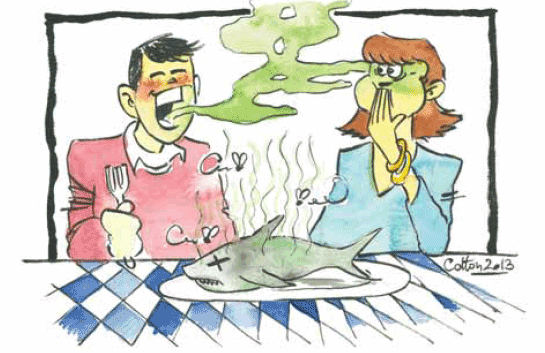

Trying the national dish of each country you visit is part of the quintessential travel experience. After all, why travel halfway across the world just to pop into McDonald’s for a Big Mac?
Some national dishes are easy on the palate, such as Singapore’s humble chicken rice — a simple dish of boiled chicken flavoured with garlic and ginger, on top of fragrant rice seasoned with sesame oil and chicken stock. Others such as Taiwan’s stinky tofu might send you scurrying back to the safety of your hotel room at the slightest whiff of its fetid odour. I have eaten stinky tofu a few times, and it actually tastes quite good — that is, once you convince yourself that what you’re putting into your mouth is not the innards of a dead animal run over several times by a garbage truck.
There are numerous ways of preparing food for consumption across the globe, reflecting the incredible diversity of our cultures. Take chicken, for example. It can be roasted in a rotisserie, braised in soya sauce, deep fried in batter, simmered as part of a curry, made into patties or sausages, served in rice balls, or even suffer the indignity of being cooked in a convection oven with a beer can stuffed up its butt. The way food is cooked or prepared can also be a reflection of how people in a particular region interact and adapt to the environment and climate.

Recently, I decided to bring Michelle to Iceland for a vacation. The tiny nation of just 320,000 inhabitants is situated high up within the Arctic Circle and is home to an array of stunning and dramatic landscapes — thunderous waterfalls, towering volcanic mountains, massive glaciers, expansive lava fields, mesmerising aurora displays and steaming geothermal pools.
The weather in Iceland can be harsh and due to its relatively isolated location, locals from generations past have relied heavily on curing and preserving meat and seafood to tide them over difficult winter spells, methods similar to those used by their Nordic neighbours. Several years ago, I had my first taste of herring pickled in brine during a work trip to Sweden, so I thought I knew what to expect from Iceland’s national dish, hakarl, or what is more commonly referred to as rotten shark.
“How bad can it be?” I thought to myself, conqueror of stinky tofu. Plus, as Singaporeans, Michelle and I love durians. Many Caucasians simply cannot understand our local obsession with the durian fruit, which has been described by some as smelling like dried vomit or skunk discharge, or a combination of both. I was therefore looking forward to trying hakarl just to see what the fuss was about.
Hakarl is prepared by first beheading a Greenland or basking shark, and burying the body in the ground at a slight incline for six to twelve weeks. The meat is then cut into strips and hung out to rot for a further four to five months. There is a very good reason behind the apparent madness of this intentional rotting, but I didn’t understand it until after I tried some of the meat.
I’d always had the false impression that hakarl was a kind of aphrodisiac, and that the rotting process served to enhance those properties. Eating hakarl, I surmised, was probably some traditional Viking show of bravado to prove a man’s love for his would-be wife — much like how my brother-in-law was coerced by my sister’s bridesmaids to drink a concoction of blended chilli, bittergourd, soya sauce, lemon juice and wasabi paste on their wedding day. This was to test his undying love for her, and only after he drank the foul-smelling cocktail was he then permitted to enter her room. Of course, nobody remembers how the cocktail left him with a leaky drainpipe for the rest of the day, but those details are best left to the annals of time.
Michelle and I purchased a small plastic tub of hakarl cubes at the Kolaportið Flea Market in downtown Reykjavik, as opposed to ordering it as a main course in a restaurant, just in case we didn’t like the taste or smell. We then went to a seafood bistro and ordered some kebabs and lobster bisque, and decided to take the plunge while waiting for our food.
I opened the tub and took a sniff. There was a hint of ammonia but the smell was still bearable.
“Hmm,” I said, as I took a bite and began to chew. “Tastes like raw swordfish. It’s not that…”
Just as I was about to utter the word “bad”, a heavy dose of ammonia shot through my nostrils, stunning me into silence. I swallowed the cube and drank a mouthful of coke but the smell lingered for another ten seconds. Michelle gleefully took a picture of the grimace on my face as she laughed, and I returned the favour a few moments later.
We brought the rest of the tub back to our apartment but eventually chickened out of having more. It was probably the worst thing either of us had ever eaten but we had done it, and had every reason to be proud of ourselves. That is, until we found out the reason behind the rotting process…
It turns out that sharks expel urine by converting it into urea and passing it through their skin. After the shark dies, the urea in its body turns into ammonia, which can be poisonous if consumed excessively. The rotting and fermentation process drains the fluids out of the shark so that the meat becomes edible… but only just barely.
So if the shark’s entire body is used to expel urine from its system, does that make it equivalent to the human organs that accomplish the same task? If so, why in heaven’s name did we eat it in the first place?!
Perhaps we should have just stuck to durians…